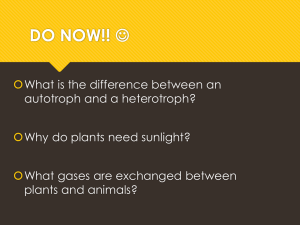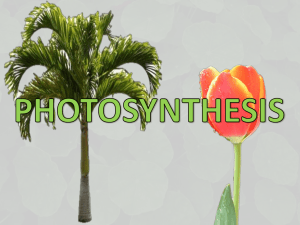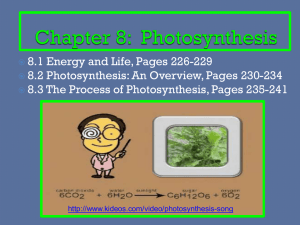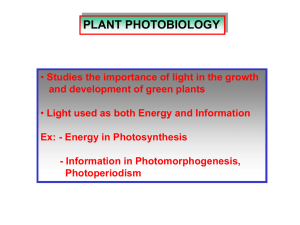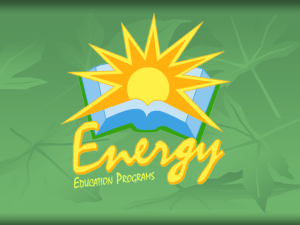Photosynthesis
advertisement
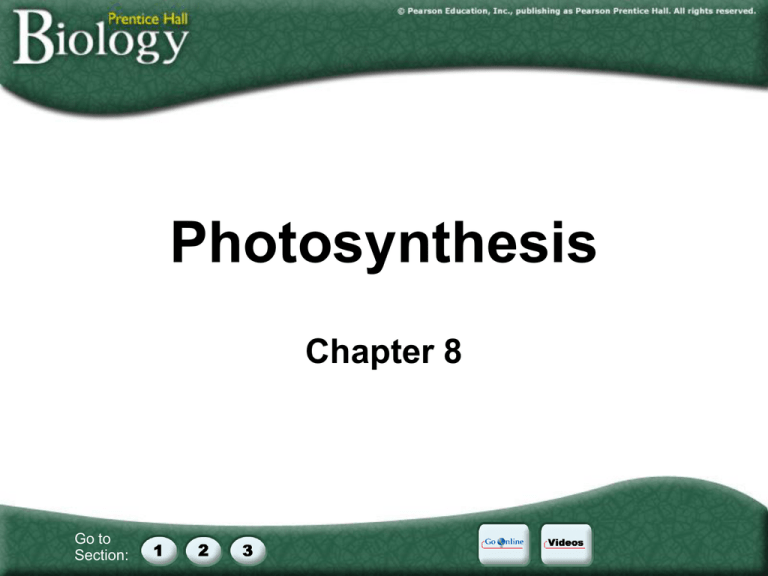
Photosynthesis Chapter 8 Go to Section: Interest Grabber Section 8-1 Saving for a Rainy Day Suppose you earned extra money by having a parttime job. At first, you might be tempted to spend all of the money, but then you decide to open a bank account. 1. What are the benefits of having a bank account? 2. What do you have to do if you need some of this money? 3. What might your body do when it has more energy than it needs to carry out its activities? 4. What does your body do when it needs energy? Go to Section: Section Outline Section 8-1 I. Energy and Life A. Autotrophs and Heterotrophs B. Chemical Energy and ATP (adenosine triphosphate) 1. principal chemical compound used in cells to store and release energy Go to Section: ATP Section 8-1 Adenine Go to Section: Ribose 3 Phosphate groups 2. Energy is primarily stored at ATP 3. To release energy the chemical bond between the second and third phosphate groups is broken producing ADP (adenosine diphosphate) Go to Section: Figure 8-3 Comparison of ADP and ATP to a Battery Section 8-1 ADP ATP Energy Adenosine diphosphate (ADP) + Phosphate Partially charged battery Go to Section: Energy Adenosine triphosphate (ATP) Fully charged battery Figure 8-3 Comparison of ADP and ATP to a Battery Section 8-1 ADP ATP Energy Adenosine diphosphate (ADP) + Phosphate Partially charged battery Go to Section: Energy Adenosine triphosphate (ATP) Fully charged battery Video 1 ATP Formation Video 1 Click the image to play the video segment. C. Using Biochemical Energy 1. ATP is used for: a. active transport of ions b. synthesis of proteins and nucleic acids c. respond to chemical signals on the cell surface 2. ATP is not good for storing large amounts of energy long term Go to Section: 3. One glucose molecule stores 90 times more chemical energy than one molecule of ATP 4. Cells can regenerate ATP from ADP as needed by using glucose Go to Section: Section Outline Section 8-2 II. Photosynthesis: An Overview A. Photosynthesis – the conversion of light energy, water, and carbon dioxide into high-energy carbohydrate (ie – glucose) Go to Section: Photosynthesis: Reactants and Products Section 8-2 Light Energy Chloroplast CO2 + H2O Go to Section: Sugars + O2 B. Photosynthesis Equation Carbon dioxide + water 6CO2 + 6H2O Go to Section: light light sugars + oxygen C6H12O6 + 6O2 Video 2 Photosynthesis Video 2 Click the image to play the video segment. C. Light and Pigments 1. Photosynthesis also requires light and chlorophyll 2. Pigments a. light absorbing molecules b. Gather the sun’s energy 3. Chlorophyll a. Principal pigment used by plants b. Chlorophyll a and chlorophyll b 4.Go Carotenoids to Section: Absorption of Light by Chlorophyll a and Chlorophyll b Chlorophyll b Chlorophyll a Go to Section: V B G Y O R Section Outline Section 8-3 III. The Reactions of Photosynthesis A. Photosynthsis takes place inside chloroplasts 1. thylakoids a. Saclike photosynthetic membranes b. Light collecting units of the chloroplasts Go to Section: Go to Section: 2. stroma a. Space outside the thylakoid membranes b. Light independent reactions or Calvin cycle occurs here Go to Section: Go to Section: B. Light-Dependent Reactions 1. require light 2. produce oxygen gas 3. convert ADP and NADP+ into energy carries ATP and NADPH Go to Section: Video 3 Light-Dependent Reactions, Part 1 Video 3 Click the image to play the video segment. Video 4 Light-Dependent Reactions, Part 2 Video 4 Click the image to play the video segment. C. Light-Independent Reactions/Calvin Cycle 1. uses ATP and NADPH from the lightdependent reactions to produce highenergy sugars 2. the ATP and NADPH formed by the lightdependent reactions contain a large amount of unstable chemical energy 3. the Calvin Cycle turns this energy into a stable form that can be stored for a long time Go to Section: Video 5 Calvin Cycle Video 5 Click the image to play the video segment. Concept Map Section 8-3 Photosynthesis includes Lightdependent reactions use to produce Go to Section: takes place in take place in of uses to produce Concept Map Section 8-3 Photosynthesis includes Lightdependent reactions use to produce Go to Section: Calvin cycle takes place in take place in of uses to produce Concept Map Section 8-3 Photosynthesis includes Lightdependent reactions use Calvin cycle takes place in take place in uses Energy from sunlight to produce Go to Section: of to produce Concept Map Section 8-3 Photosynthesis includes Lightdependent reactions use Calvin cycle takes place in take place in uses Energy from sunlight to produce ATP Go to Section: of to produce Concept Map Section 8-3 Photosynthesis includes Lightdependent reactions use Calvin cycle takes place in take place in uses Energy from sunlight to produce ATP NADPH Go to Section: of to produce Concept Map Section 8-3 Photosynthesis includes Lightdependent reactions use Calvin cycle takes place in take place in uses Energy from sunlight to produce ATP NADPH Go to Section: of O2 to produce Concept Map Section 8-3 Photosynthesis includes Lightdependent reactions Calvin cycle use take place in Energy from sunlight Thylakoid membranes to produce ATP NADPH Go to Section: takes place in of O2 uses to produce Concept Map Section 8-3 Photosynthesis includes Lightdependent reactions Calvin cycle use take place in Energy from sunlight Thylakoid membranes to produce ATP NADPH Go to Section: takes place in of O2 Chloroplasts uses to produce Concept Map Section 8-3 Photosynthesis includes Lightdependent reactions Calvin cycle use take place in Energy from sunlight Thylakoid membranes to produce ATP NADPH Go to Section: takes place in Stroma of O2 uses Chloroplasts to produce Concept Map Section 8-3 Photosynthesis includes Lightdependent reactions Calvin cycle use take place in Energy from sunlight Thylakoid membranes to produce ATP NADPH Go to Section: takes place in Stroma of O2 Chloroplasts uses ATP to produce Concept Map Section 8-3 Photosynthesis includes Lightdependent reactions Calvin cycle use take place in Energy from sunlight Thylakoid membranes to produce ATP NADPH Go to Section: takes place in Stroma of O2 Chloroplasts uses ATP NADPH to produce Concept Map Section 8-3 Photosynthesis includes Lightdependent reactions Calvin cycle use take place in Energy from sunlight Thylakoid membranes to produce ATP NADPH Go to Section: O2 takes place in Stroma uses ATP NADPH of to produce Chloroplasts High-energy sugars Figure 8-7 Photosynthesis: An Overview Section 8-3 Light CO2 Chloroplast Chloroplast NADP+ ADP + P LightDependent Reactions Calvin Cycle ATP NADPH O2 Go to Section: Sugars Figure 8-10 Light-Dependent Reactions Section 8-3 Photosystem II Hydrogen Ion Movement Chloroplast ATP synthase Inner Thylakoid Space Thylakoid Membrane Stroma Electron Transport Chain Go to Section: Photosystem I ATP Formation Figure 8-11 Calvin Cycle Section 8-3 CO2 Enters the Cycle Energy Input ChloropIast 5-Carbon Molecules Regenerated 6-Carbon Sugar Produced Sugars and other compounds Go to Section: The end Go to Section:


